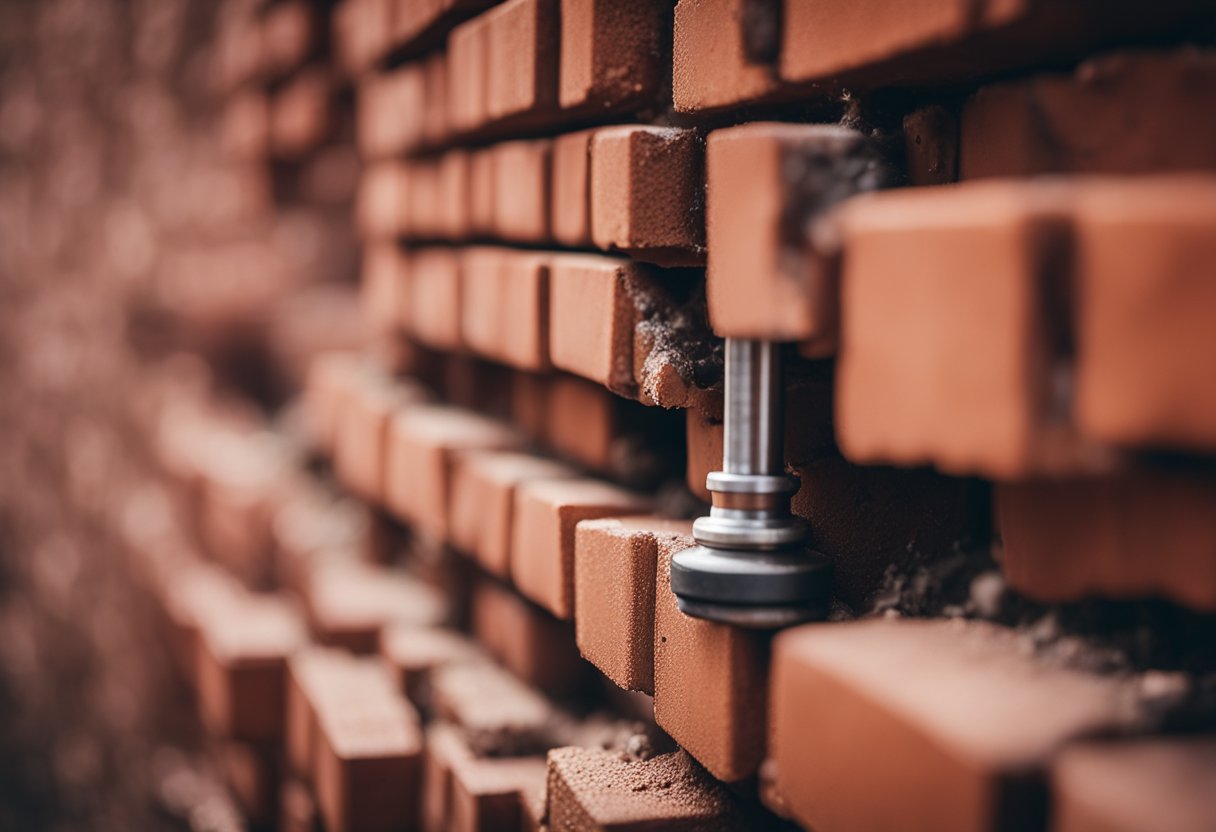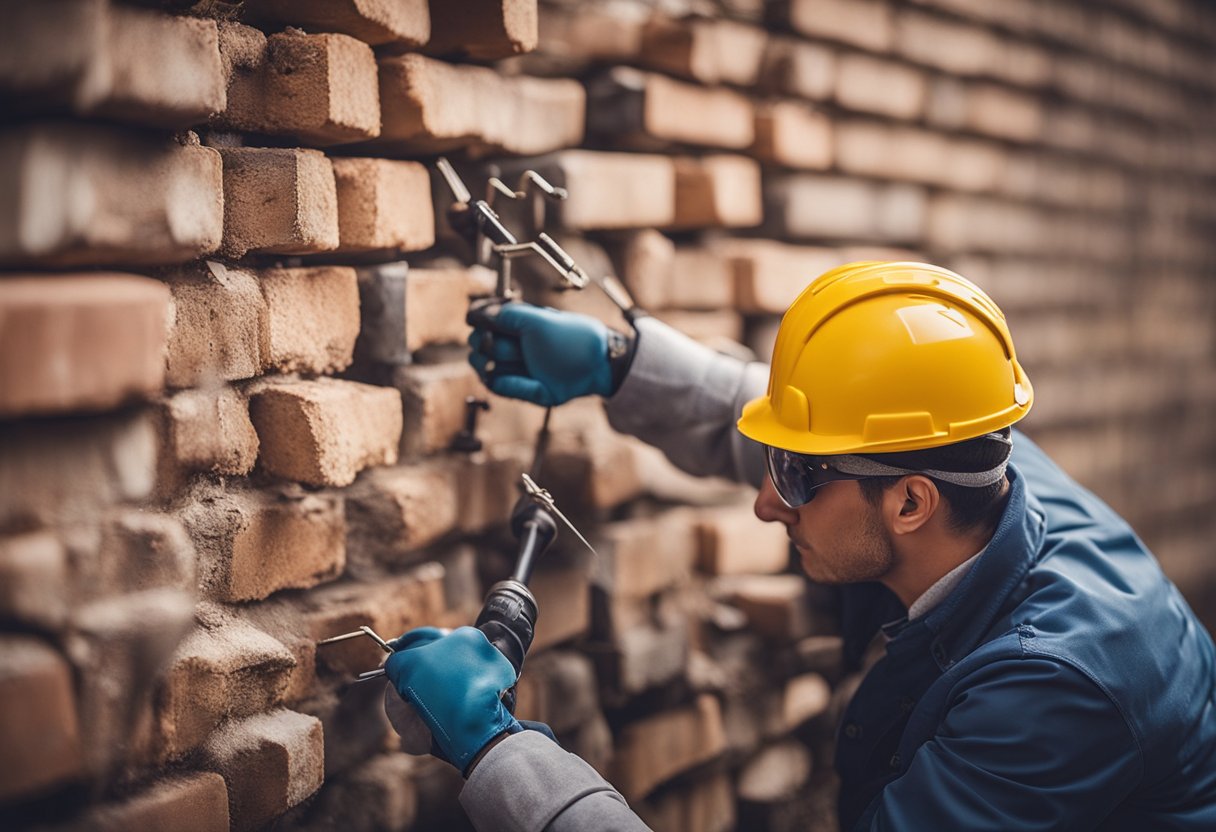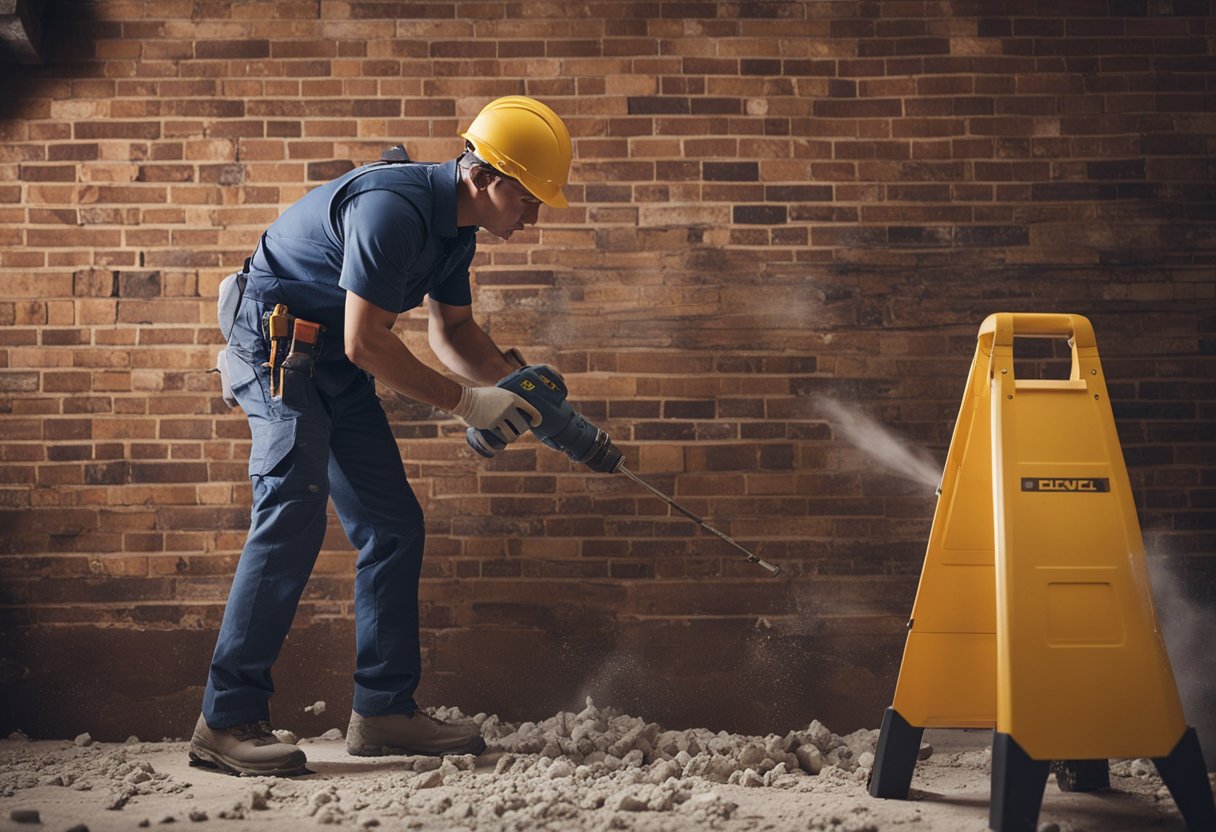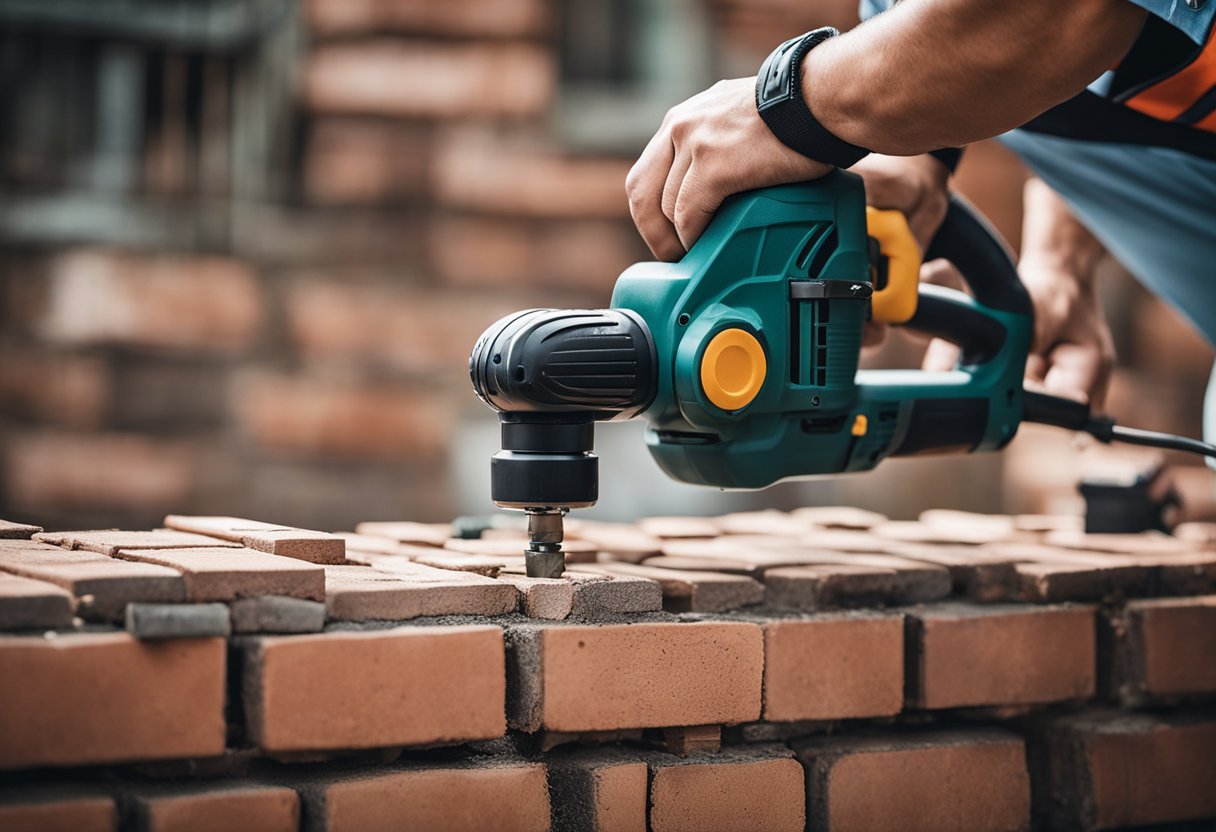Drilling into brick can be a daunting task, especially if you’re not familiar with the right techniques and tools to use. One of the biggest concerns when drilling into brick is the possibility of cracking it. However, with the right knowledge and preparation, you can drill into brick without cracking it.
Understanding the basics of drilling into brick is crucial to ensure that you get the job done right. Brick is a hard and dense material, which means that you need to use the right tools and techniques to penetrate it. In addition, you need to take safety measures and prepare the surface before drilling to minimize the risk of cracking the brick.
Key Takeaways:
- Choosing the right tools and techniques is crucial when drilling into brick to avoid cracking it.
- Safety measures and preparation steps should be taken before drilling into brick to minimize the risk of damage.
- Proper post-drilling cleanup and installation and mounting techniques are important to ensure a successful project.
Understanding the Basics
https://www.youtube.com/watch?v=ZS5IQHy0p7c&embed=true
When it comes to drilling into brick, there are a few basic things you need to understand in order to do it successfully without cracking the brick. In this section, I will cover some of the most important things to keep in mind.
Brick vs. Mortar
Before you start drilling, it’s important to understand the difference between brick and mortar. Brick is a hard, dense material that can be difficult to drill through, while mortar is a softer material that is much easier to drill through. When drilling into brick, it’s important to avoid drilling too deep and hitting the mortar, as this can cause the brick to crack.
Hammer Drill vs. Regular Drill
When drilling into brick, it’s important to use the right type of drill. A regular drill may not be powerful enough to penetrate the hard surface of the brick, while a hammer drill is specifically designed for this purpose. Hammer drills use a hammering motion to break through the surface of the brick, making it easier to drill through.
Masonry Drill Bit
Another important factor to consider when drilling into brick is the type of drill bit you use. A masonry drill bit is specifically designed for drilling into hard materials like brick and concrete. These bits are made from a harder material than regular drill bits, and they have a special shape that helps to prevent them from slipping off the surface of the brick.
Chiseling Away Mortar
Before drilling into brick, it’s important to chisel away any excess mortar or other cementation from both surfaces. This will help to ensure that the drill bit has a clear path to the brick, and it will also help to prevent the brick from cracking.
By keeping these basic principles in mind, you can successfully drill into brick without cracking it. In the next section, I will cover the step-by-step process for drilling into brick.
Choosing the Right Tools
https://www.youtube.com/watch?v=qVroeDTh7yc&embed=true
When it comes to drilling into brick, choosing the right tools is crucial to avoid cracking or damaging the brick surface. Here are the tools you will need to drill into brick safely and effectively:
1. Hammer Drill
A hammer drill is the most recommended drill for drilling into brick. It is a power drill that uses rapid hammer-like blows to bore holes into brick and concrete. The high power and speed make drilling into a brick a much smoother process. If you don’t have a hammer drill, you can use a regular drill with the correct technique.
2. Masonry Drill Bit
Using the right drill bit is crucial when drilling into brick. You’ll want to use a masonry bit designed to drill into hard materials like brick. These bits are typically made of carbide or diamond and have a pointed tip that can break through tough surfaces. Make sure to choose the right size drill bit for the size of the hole you need.
3. Screw and Wall Anchor
Once you’ve drilled your hole, you’ll need a screw and a wall anchor to secure your object to the brick surface. Choose a screw and anchor that are the appropriate size for the weight of the object you’re hanging.
4. Tape Measure and Pencil
Before drilling your hole, use a tape measure and pencil to mark the exact spot where you want to drill. This will ensure that your hole is in the right place and at the right depth.
5. Safety Gear
Drilling into brick can create a lot of dust and debris, so it’s important to wear the right safety gear. Wear safety glasses, gloves, and a dust mask or N95 respirator to protect yourself from dust and debris. If you’re drilling for an extended period, consider using earplugs to protect your hearing.
6. Shop Vac or Can of Compressed Air
After drilling your hole, use a shop vac or can of compressed air to remove any dust or debris from the hole. This will ensure a clean and secure fit for your screw and anchor.
7. Bubble Level
Use a bubble level to make sure that your object is straight and level before securing it to the wall. This will ensure that your object hangs properly and looks its best.
By using the right tools and safety gear, you can drill into brick without cracking or damaging the surface.
Safety Measures
When drilling into brick, safety should be the top priority. Here are some safety measures that I follow to ensure a safe drilling experience:
-
Protective Gear: I always wear protective gear such as goggles to protect my eyes from dust and debris. It’s important to wear gloves to protect your hands from sharp edges and cuts.
-
Dust Control: Drilling into brick can create a lot of dust, which can be harmful to your health. I use a dust mask to prevent inhalation of dust particles.
-
Water: I make sure to keep a bucket of water nearby to cool down the drill bit and prevent it from overheating. This also helps to reduce dust and debris.
-
Pipes and Wires: Before drilling, I make sure to locate any pipes or live wires behind the wall. I use a stud finder to locate electrical wiring and outlets. It’s important to avoid drilling into these areas to prevent electrical shocks or flooding.
By following these safety measures, I can ensure a safe and successful drilling experience.
Preparation Steps
Before drilling into brick, it is crucial to take several preparation steps to ensure that the process goes smoothly without any damage to the brick or surrounding areas. Here are some steps that I recommend taking:
Measure and Mark
First, determine the location where you want to drill the hole. Use a measuring tape to measure the distance from the edge of the brick to the desired location. Then, use a pencil to mark the location on the brick. This will help you drill the hole in the exact location you need it.
Masking Tape
To further ensure that you drill the hole in the right location, you can use masking tape to create a guide. Simply place a piece of masking tape over the marked location and use a pencil to mark the center of the hole on the tape. This will help you see exactly where you need to drill.
Masonry or Mortar Drill Bits
When drilling into brick, it is important to use the correct type of drill bit. Masonry or mortar drill bits are designed specifically for drilling into hard materials such as brick. These bits are made of carbide or diamond and have a pointed tip that can break through tough surfaces.
Drill Bit Size
The size of the drill bit you use will depend on the size of the hole you need to drill. Be sure to choose a drill bit that is the appropriate size for the job. Using a drill bit that is too small or too large can cause damage to the brick.
Depth Gauge
To ensure that you drill the hole to the correct depth, you can use a depth gauge. This tool will help you measure the depth of the hole as you drill, so you know when to stop.
Sleeves
If you are drilling a larger hole, you may need to use sleeves to protect the brick from damage. Sleeves are plastic or metal tubes that fit into the hole and provide a protective barrier between the drill bit and the brick.
Depth-Stop Attachment
Another tool that can help you drill the hole to the correct depth is a depth-stop attachment. This attaches to the drill and allows you to set the depth to the exact measurement you need. This can be especially helpful if you are drilling multiple holes to the same depth.
By taking these preparation steps, you can ensure that you drill into the brick without cracking it.
Drilling Techniques
https://www.youtube.com/watch?v=lR98Jyvfpbk&embed=true
When drilling into brick, it is important to use the right drilling technique to avoid cracking the brick. Here are some techniques that I use to drill into brick without cracking it:
Choose the Right Drill Bit
The first step to drilling into brick without cracking it is to choose the right drill bit. A carbide-tipped masonry bit is the best choice for drilling into brick. These bits are designed to drill through hard materials like brick and concrete. They have a sharp tip that can penetrate the surface of the brick without cracking it.
Start with a Pilot Hole
If you are drilling a deep hole or a large hole, it is a good idea to start with a pilot hole. A pilot hole is a small hole that you drill first to guide the larger drill bit. This will help you to drill the hole more accurately and prevent the drill bit from wandering.
Use Low Speed and Steady Pressure
When drilling into brick, it is important to use a low speed and steady pressure. This will help to prevent the drill bit from overheating and reduce the risk of cracking the brick. Apply steady pressure to the drill and let the bit do the work. Do not force the drill into the brick.
Maintain Stability and Precision
To drill into brick without cracking it, it is important to maintain stability and precision. Hold the drill firmly with both hands and keep it perpendicular to the surface of the brick. This will help you to drill the hole straight and prevent the drill bit from wandering.
Avoid Overheating
Overheating can cause the drill bit to dull or break, and it can also cause the brick to crack. To avoid overheating, use a low speed and steady pressure, and periodically stop drilling to allow the drill bit to cool down. You can also dip the drill bit in water to cool it down.
In conclusion, drilling into brick without cracking it requires the right technique, the right drill bit, and the right approach. By following these techniques, you can drill into brick with precision and accuracy, and avoid damaging the brick.
Post-Drilling Cleanup
After drilling into brick, there will likely be dust and debris left behind. It’s important to clean up properly to avoid any potential hazards or damage to the surrounding area.
I recommend using a broom and dustpan to sweep up any loose debris. If there is a lot of dust, a shop vac or shop vacuum with a HEPA filter can be used to suck up the dust. A can of compressed air can also be used to blow away any remaining debris.
Once all the debris has been removed, it’s important to mop the area with water to remove any remaining dust particles. This will ensure that the area is clean and safe to work in.
It’s important to note that drilling into brick can create a lot of dust, so it’s a good idea to wear a dust mask and eye protection during the drilling process. This will help to protect your lungs and eyes from any harmful particles.
Overall, proper post-drilling cleanup is essential to ensure a safe and clean work environment. By following these steps, you can ensure that your work area is clean and free of any potential hazards.
Installation and Mounting
https://www.youtube.com/watch?v=Lo7veFXq29A&embed=true
When it comes to mounting items on a brick wall, it’s important to choose the right hardware to ensure a secure and long-lasting installation. Whether you’re mounting shelves, cabinets, artwork, or any other type of item, selecting the right screws or anchors is crucial.
One option for mounting items on brick is to use expansion-style anchors. These anchors work by spreading out once they are inserted into the wall, creating a secure hold. However, it’s important to choose the right size anchor for the weight of the item you’re mounting. Using an anchor that is too small can result in a weak hold, while using one that is too large can cause the brick to crack.
Another option is to use anchor screws. These screws have a special design that allows them to grip the brick tightly, providing a secure hold. However, it’s important to choose the right size screw and drill bit for the job. Using a screw that is too small can result in a weak hold, while using one that is too large can cause the brick to crack.
Before drilling into the brick, it’s important to mark the location where you want to mount the item. Use a level to ensure that the item will be mounted straight. Once you have marked the location, use a hammer drill and the appropriate drill bit to create a hole in the brick. Be sure to use a low speed and apply gentle pressure to avoid cracking the brick.
Once the hole is drilled, insert the anchor or anchor screw into the hole and use a screwdriver to tighten it. Be sure to follow the manufacturer’s instructions for installation and weight limits. With the right hardware and proper installation, you can mount items on a brick wall without cracking the brick.
When to Consult Professionals
As a DIY enthusiast, it can be tempting to take on every project, including drilling into brick walls. However, it is important to know when to consult professionals. Drilling into brick requires patience, the right tools and materials, and a steady hand. If you lack any of these, it is best to leave the job to professionals.
One of the main reasons to consult professionals is to avoid damage to the brick wall. If you drill into the wrong spot or use the wrong drill bit, you risk damaging the brick. This can result in cracks or even the entire wall collapsing. Professionals have the expertise and experience to avoid such damage and ensure that the job is done correctly.
Another reason to consult professionals is if you lack the right tools and materials. While a regular drill can be used for drilling into brick, a hammer drill is recommended for larger holes and stronger bricks. Additionally, the right drill bits and screws are essential for a successful project. Professionals have access to high-quality tools and materials, ensuring that the job is done right the first time.
If you lack experience drilling into brick, it is best to consult professionals. Drilling into brick requires patience and a steady hand. It is important to drill at the right speed and apply the right amount of pressure. If you rush the job or apply too much pressure, you risk damaging the brick. Professionals have the experience to avoid such mistakes and ensure that the job is done right.
In summary, while drilling into brick can be a satisfying DIY project, it is important to know when to consult professionals. If you lack experience, the right tools and materials, or simply want to avoid damage to your brick wall, it is best to leave the job to professionals. Tools such as DeWalt Hammer Drills are a great choice for professionals, and can provide the necessary power and speed to make drilling into brick a much smoother process.
Frequently Asked Questions
https://www.youtube.com/watch?v=hkpfegLfZ6Q&embed=true
What is the best drill bit for drilling into brick?
The best drill bit for drilling into brick is a masonry bit. A masonry bit is designed to drill through hard materials like brick, concrete, and stone. These bits have a tungsten carbide tip that is specifically designed to withstand the hardness of the brick. You can find masonry bits in different sizes, so make sure to choose the right size for your project.
How do you drill into brick with a regular drill?
To drill into brick with a regular drill, you need to use a masonry bit and follow the proper technique. First, mark the spot where you want to drill the hole. Then, use a hammer and a nail to create a small indentation in the center of the mark. This will help guide the drill bit. Next, insert the masonry bit into the chuck of the drill and tighten it. Finally, turn on the drill and apply steady pressure as you drill into the brick.
What is the proper drill setting for drilling into brick?
The proper drill setting for drilling into brick is the hammer drill setting. This setting is designed for drilling into hard materials like brick, concrete, and stone. The hammer drill setting creates a back and forth motion that helps break up the hard material as you drill. This makes it easier to drill through the brick without cracking it.
Can a cordless drill be used to drill into brick?
Yes, a cordless drill can be used to drill into brick, but it is important to choose the right drill. A hammer drill is the best type of cordless drill to use for drilling into brick. The hammer drill setting will help break up the hard material as you drill, making it easier to drill through the brick without cracking it.
How do you drill into brick without cracking it?
To drill into brick without cracking it, you need to follow the proper technique. First, make sure you are using a masonry bit and a hammer drill. Next, mark the spot where you want to drill the hole and create a small indentation in the center of the mark using a hammer and a nail. Then, apply steady pressure as you drill into the brick. Make sure to keep the drill perpendicular to the surface of the brick and avoid applying too much pressure or drilling too quickly.
What is the recommended speed for drilling into brick?
The recommended speed for drilling into brick is slow and steady. You want to avoid drilling too quickly, as this can cause the drill bit to overheat and break. Instead, apply steady pressure and drill at a slow, consistent speed. This will help you drill through the brick without cracking it.

Hi, I’m Sal Muller of Tooltrip.com. My DIY experience led me to understand essential power tools for home projects. Tooltrip.com guides enthusiasts and professionals in choosing right tools for any job. I provide concise top tool reviews for easier, efficient DIY.






